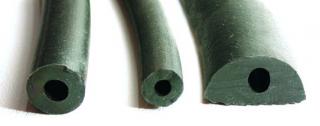Road tube is the most common short term data collection method for traffic counting and classification. Two main reasons for this is the data collected is accurate and economical compared with other detection methods.
Road tubes are used to detect vehicle axles by sensing air pluses that are created by each axle (tire) strike of the tube in the roadway. This air pulse is sensed by the unit and is recorded or processed to create volume, speed, or axle classification data. While one road tube is used to collect volume, two road tubes can be used to collect speed and class data.
Road tube comes in coiled lengths and is made most commonly from two types of material (EPDM and Isoprene rubber). EPDM synthetic tube is a rubber that is made to be durable and robust in most environments. Natural Isoprene tube is more soft and is used in colder climates. Both types are available in different sizes (9/16" and Mini Low Profile) to accommodate users.
Road Tube holds up well in sunlight and in all weather conditions except they have a particular aversion to street sweepers and snow plows. The life span of road tube varies depending on the location, installation and volume of traffic.
Are you installing Road Tubes soon? Check out our General Guidelines for Road Tube Installation.





